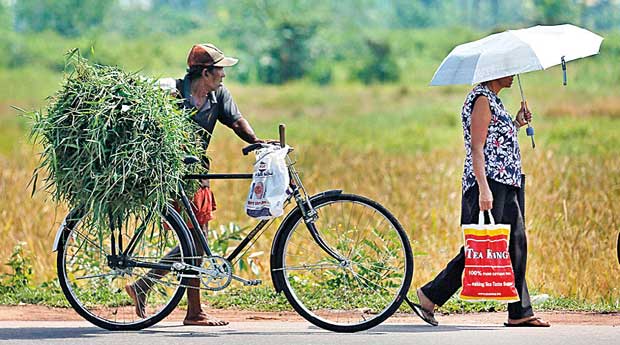Reply To:
Name - Reply Comment
Last Updated : 2024-04-25 11:13:00
 A farmer transports paddy on his bicycle next to a woman in Colombo. Sri Lanka’s Central Bank unexpectedly raised its key policy interest rates by 50 basis points on Friday from a record low, to prevent demand-driven inflationary pressure
A farmer transports paddy on his bicycle next to a woman in Colombo. Sri Lanka’s Central Bank unexpectedly raised its key policy interest rates by 50 basis points on Friday from a record low, to prevent demand-driven inflationary pressure
(Reuters Picture)
The Central Bank tightened Sri Lanka’s monetary policy by raising its key policy rates by 50 basis points last Friday in a bid to cool down an overheating economy as the excessive credit growth was seen fuelling demand-driven inflationary pressures.
The Monetary Board accordingly raised its standing deposit facility rate (SDFR)—the rate at which the Central Bank absorbs banking sector excess liquidity—and the Standing Lending Facility Rate (SLFR)— the rate at which the Central Bank injects liquidity—by 50 basis points to 6.5 percent and 8.0 percent, respectively.
The SLFR now stands where it was before April 2015 when the Central Bank surprised the markets by cutting the rate by 50 basis points despite an expanding fiscal deficit and evident signals of private credit rising to unsustainable levels.
The growth-biased Central Bank appeared to have not factored in the general lag in monetary transition—the time taken for the monetary policy decisions to take effect in the real economic activities—which, in Sri Lanka’s case takes a little longer than
the usual.
As repeatedly cautioned by the top independent economists in the country, this resulted in the country being tilted towards a balance of payment crisis.
“…. in spite of the recent policy measures taken by the Central Bank and some upward adjustments observed in market interest rates, certain risks to macroeconomic stability continue.
In particular, the Monetary Board was of the view that the excessive growth of broad money fuelled by domestic credit expansion in the midst of continued upward trend in underlying inflation required pre-emptive policy measures in order to contain further build-up of demand driven inflationary pressures,” the Central Bank said in its February monetary policy statement. The market largely expected a rise in policy rates, as the interest rates were on the up since the beginning of the third quarter in 2015. The Central Bank was seen printing excessive money to keep the rates artificially low and the unintended consequence of this exercise was an unsustainable credit boom.
At present, the country is contemplating a bailout package from the International Monetary Fund. This cycle of ‘boom and bust’ has been prevalent since 1980s in Sri Lanka.
This is the second such move by the Central Bank in a matter of two months as the monetary authority began the tightening cycle by raising the reserve ratio by 150 basis points to 7.50 percent on December 30, 2015, effective January 16, 2016. The move has already pushed up the banks’ lending rates by 150 to 200 basis points as it created a liquidity crunch in money markets. The banks are finding it challenging to fund the loan book growth, albeit slower than in 2015, and are offering much higher rates for deposits.
The debt capital market is also expected to see a slew of debenture issues in the coming months, mostly by the banks and financial sector companies.
The banks lent over and above what they could raise through deposits and thus 2015 saw the highest private credit growth in Sri Lanka in any year in absolute terms.
In 2015 the banking sector extended a total private credit of Rs.691.4 billion, a growth of 25.1 percent from the total outstanding private credit by the end of 2014. In 2014 total credit extended to the private sector was Rs.223.9 billion.
Cheaper bank credit, rising consumer demand amid lower taxes and higher disposable income pushed the total private credit in 2015 and it hit an all time monthly high of Rs.158 billion in October before falling to Rs.91.2 billion in November. “Broad money (M2b) continued to grow at a high pace, recording a growth of 17.8 percent year-on-year in December 2015 compared to 13.4 percent in December 2014,” the Central Bank said.
Although the headline inflation is still in low-single digit levels due to low global commodity prices and broadly favourable supply conditions, the core-inflation continued to rise reaching 4.6 percent in January 2016 on a year-on-year basis.

Add comment
Comments will be edited (grammar, spelling and slang) and authorized at the discretion of Daily Mirror online. The website also has the right not to publish selected comments.
Reply To:
Name - Reply Comment
US authorities are currently reviewing the manifest of every cargo aboard MV
On March 26, a couple arriving from Thailand was arrested with 88 live animal
According to villagers from Naula-Moragolla out of 105 families 80 can afford
Is the situation in Sri Lanka so grim that locals harbour hope that they coul